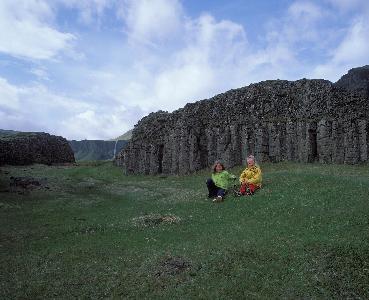Vinna við nýjar heimasíður Umhverfis- og orkustofnunar og Náttúruverndarstofnunar er í gangi. Heimasíða Umhverfisstofnunar er virk á meðan vinnunni stendur. Information in English
Dverghamrar

Dverghamrar are especially beautifully shaped columnar basalt cliffs that jut out into the plains. The cliffs are made from basalt, and the columns are large, with individual columns reaching up to 1 metre in diameter. On top of the columnar basalt is so-called hackly jointed lava.
Columnar basalt like that found in Dverghamrar is formed during the cooling process of fresh lava flows. After the lava has solidified, it keeps on cooling down; as it cools, the rock contracts. Finally, the lava splits into columns, which are usually pentagonal or hexagonal. The columns are always perpendicular to the cooling surface, which means that they stand vertically in lava layers, like in Dverghamrar. In the upper part of the freshly flowed lava, the cooling happens faster than in its core. With faster cooling, the hackly jointed lava is formed, which can be seen on top of the shapely columns. Near the end of the last ice age, the sea level near Iceland was higher, and it is believed that the current appearance of the cliffs was shaped by sea erosion at the time.
Dverghamrar was protected as a natural monument in 1987. The natural monument covers an are of 2.14 ha.